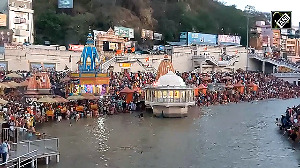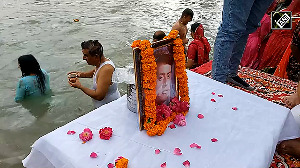Prime Minister Narendra Modi on Wednesday visited the historic Mazargues Cemetery in Marseille city in France along with French President Emmanuel Macron and paid tribute to the Indian soldiers who made sacrifices fighting in the Great War.

At a solemn ceremony held at the site, Modi laid a wreath composed of tricolour-themed flowers and Macron also laid a wreath.
Paying homage to the soldiers who laid down their lives fighting shoulder-to-shoulder with their French counterparts during World War I, Modi paid tribute with folded hands and a gentle bow at the iconic site that also has an 'Indian Memorial'.
A band played on the lawns enhancing the solemnity of the occasion.

Later, the two leaders took a walk on the premises of the cemetery and laid roses on memorial tablets installed on a wall inside a stone pavilion at the historic cemetery.
A large number of Indian soldiers are commemorated in this war cemetery that is maintained by the Commonwealth War Graves Commission (CWGC).
Modi, who is on a three-day visit to France, on Tuesday co-chaired the AI Action Summit along with President Macron and addressed business leaders.
He arrived in Paris on February 10.
The First World War, also called the Great War, took place during 1914-18 while the Second World War happened during 1939-45.
According to the website of the CWGC, "There are now 1,487, 1914-18 and 267, 1939-45 war casualties commemorated in this site. 205 of the Indian casualties, who were cremated, are commemorated on a memorial at the rear of the cemetery."
The Mazargues Indian Memorial was unveiled by Field Marshal Sir William Birdwood in July 1925.
"In addition, eight members of the Egyptian Labour Corps, who were buried in Le Canet New Communal Cemetery at the time, but whose graves were later lost, are commemorated on a stone tablet on the left-hand wall of the war cemetery," it said.

The cemetery covers an area of 9,021 sq m, as per the CWGC website.
Mazargues is a southern suburb (the 9th Arrondissement), some six kilometres from the centre of Marseilles in France.
Marseilles was the base of the Indian troops in France during the 1914-18 war and throughout the War the Royal Navy, the Merchant Navy, British troops and labour units worked in the port or passed through it, the CWGC website said.
Four of the town cemeteries were used, in the main, for the burial of officers and men of the Commonwealth forces who died at Marseilles. At St. Pierre Cemetery, on the east side of the town, the bodies of Hindu soldiers and labourers were cremated in 1914-16.
Le Canet Old Cemetery and Le Canet New Cemetery, on the north side, were in 1917-19, the places of burial for Indian soldiers and Indian, Egyptian and Chinese labourers, it added.
Mazargues Cemetery, on the south-east side, was used less in the War, but before the Armistice, an extension was made, to which were removed, a little later, the bodies or ashes from the four town cemeteries and from Port St. Louis-du-Rhone Communal Cemetery, according to the Commonwealth War Graves Commission.
In April 2015, Prime Minister Modi during his visit to France paid homage to the World War I memorial in Neuve Chapelle, to honour around 4,700 Indian soldiers who laid down their lives in battles in France and Belgium during the Great War.
"Our soldiers who fought in foreign lands in the Great War, have won the admiration of the world for dedication, loyalty, courage and sacrifice. I salute them," the Prime Minister had written in the visitor's book at the memorial.











 © 2025
© 2025